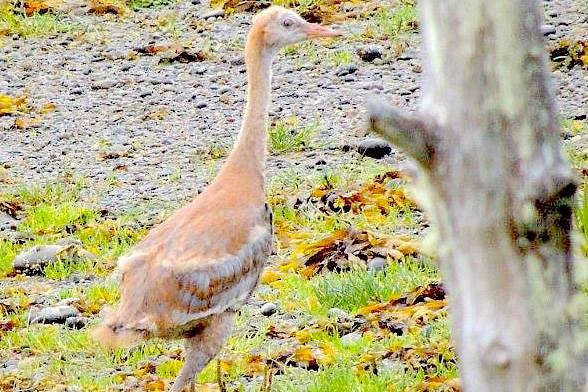Just like nearly everyone we know here, we have a bird feeder. It supplies lots of entertainment this time of the year. Chickadees and nuthatches cavort all day from trees to feeder and back again, trying to be king of the hill. We put out suet along with seeds that attract Stellar’s Jays, too. We can count on one to show up at noon every day. I think he had a route he follows, and we are lunch.
When we first moved into this neighborhood, we saw golden-crowned sparrows, crimson grosbeaks, redpolls, and sundry other small birds all year. That was long enough ago that the street was not yet paved, our mailbox was in front of the house on a post and we had little kids up and down the street all day. In time, the city paved and striped the street; the mail box changed to a cluster box on the side street, and the kids grew up. The bird population changed, too.
As traffic found our paved shortcut through town connecting the highways, different species moved in and out. The golden-crowned sparrows were the first to go, then the grosbeaks and redpolls. Chickadees aren’t afraid of anything. They thrive on attention, it seems, and the nuthatches are ornery and feisty, so they both stayed, and the Steller’s jays moved in. A little wary at first, they soon added our feeder to their daily flit through town, and even in summer make our yard their convention center. We see robins by the end of April, and other thrushes, as well as regular sparrows and wrens. Even Bohemian waxwings make a short appearance late in the year as the Mountain Ash berries freeze and (probably) start to ferment. And we have had an eagle every now and then perch in the big tree.
I am not really a bird watcher, as such. I don’t go on the Christmas bird count, or carry binoculars with me to see if I can score a rare find, but I like to see the birds in our yard and around the feeder, and I always look for the sandhill cranes on Bridge Access Road and the swans on the way to Anchorage. They are my assurance that all’s right with the world if they are when and where I expect them to be.
This past few weeks I have had a research project of looking for something in the Clarion from 1979-80, which happens to coincide with when we moved into this neighborhood. The trouble with that kind of job is that it is so easy to spend a lot of time reading the old news. I’ve been reminded of old scandals (which reminds me of something my mom said once during a crisis in my young life: “Will this be important in five years?”) I’ve recognized names from long ago, and come to understand the changes in our town and country through 20/20 hindsight.
What really caught my attention is the national news 40 years ago. In 1979, at the end of Jimmy Carter’s presidency, Iran and Saudi Arabia were the foreign adversaries and oil was prominent. Sound familiar? “ERA [equal rights amendment] will not result in unisex bathrooms” was another headline. (Shades of LGBTQ). NOW [National Organization of Women] was advocating for more women in positions of power, albeit a little more sedately than the current #MeToo movement. At the same time, headlines were touting several women judges, the girls sports teams at KCHS were winning tournaments and females generally were going about their daily lives as fisher persons or doctors unaware they were being oppressed much as they do today. The more things change, etc.
Rolling through the microfilm, I recall the format of the Clarion of the era, and miss some of the ‘old hometown’ flavor of that paper. Announcements of engagements, pictures of brides, a column of ‘recent births’ from the hospital. “Horse Talk” and “Art Council Comments” were a regular columns, and each week a section that featured a segment of the population at work in pictures and prose: fishermen, artists, organizations.
What does all this have to do with my bird feeder you might ask. Absolutely nothing, except as a counterpoint to the realization that everything changes, for better or worse. Improvements, like paving a street, are bound to bring other changes which may not be as positive, like more traffic which prompts birds to change their habitat.
Forty years has made us more aware (and I hope more accepting) of different life styles and cultures, but at the expense of our own autonomy and the death of civil conversation because one dares not express a dissenting opinion in fear of offending and/or alienating someone. Identity politics reigns.
Then I see the chickadees in the trees scolding the nuthatch sitting on the suet daring them to come closer, and I realize that change is inevitable, growth is optional.
• By Virginia Walters

